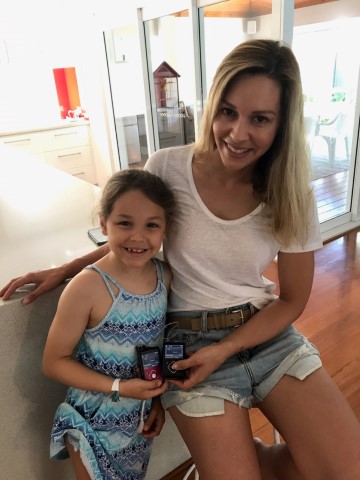 “I sometimes wish I wasn’t the only one in my family with type 1.”
“I sometimes wish I wasn’t the only one in my family with type 1.”
It was this simple statement that prompted mum Candice to walk in her seven-year-old daughter Mia’s shoes to attempt to discover what life is like living with type 1 diabetes. Mia was diagnosed with type 1 at just three years old and was placed on pump therapy six months after her diagnosis.
“It broke my heart because for the first time ever she was embarrassed to be her beautiful self,” Candice said.
“I decided then that I would put on one of Mia’s Libre sensors and I rang the diabetes clinic and asked if I could borrow a pump to wear over the summer school holidays.
“I wanted Mia to be involved and see that I was not embarrassed to wear all the things she has to wear for her diabetes — I wanted her to have her confidence back again.
“I also thought it would be a pretty cool experience for me to see what she has to deal with and remember in her day. That would also help me in managing her diabetes.”
Candice borrowed a demonstration pump from the clinic which was infused with saline. Her daughter Mia then put the pump site on and showed her how to use it.
“We had a complete role reversal and I think Mia loved it,” she said. “She got to look after me for a while and it made her feel quite important.
“Mia obviously really needed someone else to be ‘in it’ with her and would tell pretty much everyone that I had a pump and a sensor and show them.
“She would test me, and we would often take our blood glucose level (BGL) together and play a game of trying to guess the other person’s BGL.”
Candice said it did not take long for Mia’s mindset to improve.
“It did not take long for her to see that I did not care what people thought and was not embarrassed,” she said.
“After this, she started to feel the same and I could see her confidence come back.
“Mia has approached the new school year with much more happiness and enthusiasm and she was recently asked by her teacher if she would like to speak to the class about her type 1 and she very quickly responded with a ‘yes’.”
Candice said the whole experience reinforced to her just how much Mia had to remember daily to manage her diabetes.
“I gained a lot of insight and even more so now I am determined to prolong this responsibility being put on to her until she is ready,” she said.
“I think just because your child can bolus themselves, count carbs and use the pump, it does not mean that they are mentally ready to take that on.
“I learnt so much and have a great deal of empathy for what Mia manages and lives with. I really do feel that when you have had to ‘walk in someone’s shoes’ so to speak you always understand everything better yourself.”
Liz Broad, Acting Clinical Nurse consultant and Diabetes Educator at Perth Children’s Hospital’s Department of Diabetes and Endocrinology, commended Candice for wearing a pump to support Mia’s diabetes journey and encouraged others to give it a try if their child was having a hard time.
“This idea can change the 'difference' to a more positive one — reframing experiences can be helpful in turning things around,” she said.
The Children’s Diabetes Centre, based at The Kids Research Institute Australia, is an integrated clinical and research centre that aims to improve the lives of children, adolescents and young adults living with diabetes.
Professor Tim Jones, Co-Director of the Children’s Diabetes Centre, based at The Kids Research Institute Australia, said researchers were investigating how pump technology could improve blood glucose control and automatically regulate insulin delivery.
For more information on the Centre’s technology research, visit this page.
